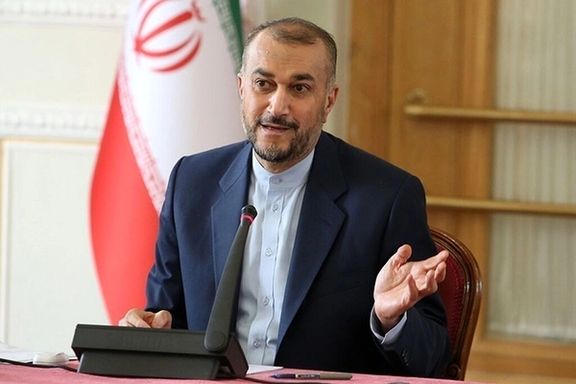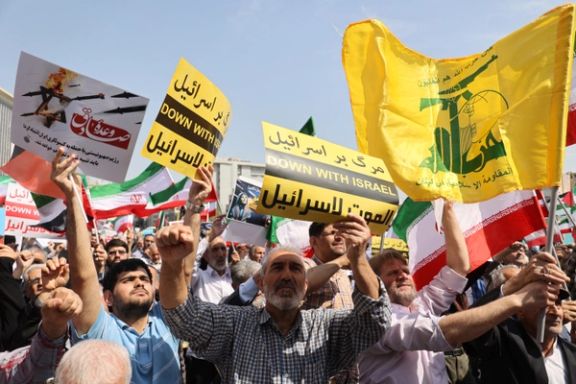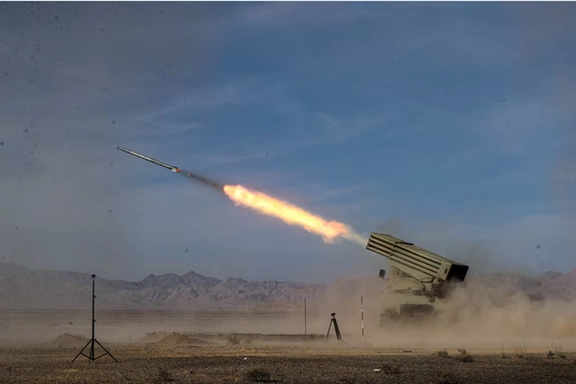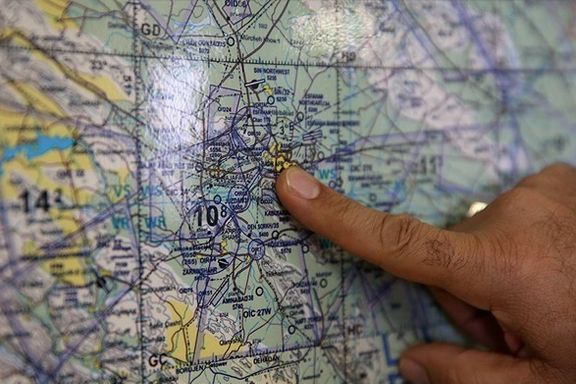Iran FM Refuses To Acknowledge Israel Striking Airbase

Iran’s Foreign Minister Hossein Amir-Abdollahian refrained from acknowledging that Israel had a part in the Friday attack on a airbase in Iran as Tehran attempts to quell war talk.

Iran’s Foreign Minister Hossein Amir-Abdollahian refrained from acknowledging that Israel had a part in the Friday attack on a airbase in Iran as Tehran attempts to quell war talk.
“It has not been proven to us that there was a connection between this and Israel,” he said in an interview with NBC News.
Early Friday morning, explosions were heard in Esfahan's 8th Shekari Air Base as Israel reportedly launched a widely anticipated strike in retaliation to an Iranian aerial assault last weekend.
In an attempt to downplay the incident, Amir-Abdollahian said what happened “was not a strike.” According to Iran’s top diplomat, the projectiles used in the incident were “more like toys that our children play with.”
“They took off from inside Isfahan and they flew for a few hundred meters and then they were downed and struck by our air defense,” he went on to say, in what appears to be a veil to avoid retaliation as international powers push for calm.
Meanwhile, New York Times reported that according to the analysis of satellite imagery, the Friday precision strike on Isfahan (Esfahan) damaged or annihilated the “flip-lid” radar, a significant part of the air defense system in Shekari Air Base.
Prior to the incident, four trucks with missiles were positioned around the radar but the satellite images show they were not damaged in the strike. “The fact that they appear undamaged indicated that the attack had a very precise target,” New York Times wrote, citing a former US government imagery analyst.
Israel has not officially commented on the attack.
Tensions between Iran and Israel have risen sharply over recent weeks. On April 1, Israel launched a precision missile strike on Iran's consulate building in Damascus, killing 7 IRGC senior officers, including two senior commanders. In retaliation, Iran launched its first ever direct offensive against Israeli territory last weekend with more than 350 drones and cruise and ballistic missiles. Most were intercepted in a joint operation between Israel and its allies in a US-led coalition.

US and Iraqi companies have signed two deals, seemingly aiming to make the country independent from Iranian gas and electricity imports that provide billions of dollars to Tehran.
The deals are meant to capture Iraqi associated gas from oilfields, currently being flared due to lack of gas collecting equipment.
The US State Department released a joint statement after sealing the deal with Iraq, saying that the US has the potential to harness immense natural gas resources, invest in new energy infrastructure and renewables, and achieve energy self-sufficiency by 2030.
“The United States commended Iraq for its progress on gas capture and work on commercializing associated gasses,” the statement read.
Currently Iraq flares about 18 billion cubic meters (bcm/yr) of associated gas, ranking the second globally after Russia.
This amount of gas waste is two times more than Iraq’s annual gas imports from Iran.
Since the United States imposed banking sanctions on Iran in 2018, Iraq was not able to make cash payments to Iran, leading to the accumulation of around $11 billion in unpaid bills. The Biden administration, however, offered waivers to Iraq starting in June 2023 and the debt was paid in Oman, from where Iran is supposed to spend the money for buying "unsanctionable" goods.
However, critics have slammed the Biden administration for this decision, arguing that money is fungible and any hard currency Iran is able to access means that it can spend other currency resources on its military and other destabilizing activities.
Iraq's electrical grid has for years been dependent on gas imports from Iran to run its power generation plants. Iraq loses 4,000 to 5,000 MW of its electricity generation in some months, especially in winter and summer, due to halting Iranian gas and electricity deliveries to this country. Iran’s gas shortage soars to 250-300 mcm/d in winters and faces a 14,000 MW electricity shortage in summers, forcing it to reduce supplies to Iraq.
The country needs 40,000 MW of electricity, but its current generation capacity stands at 27,000 MW, of which 30% uses Iranian gas.
Iraq has projected to stop gas flaring by 2028 and reach energy self-sufficiency by 2030. It is working to reduce its heavy reliance on Iranian energy supply, which is subject to sanctions, requiring the US to issue waivers every four months.
Though Iraq recently extended a gas import deal with Iran for next five years, it has been trying to diversify energy import sources, including Turkmen gas import through Iran.
The joint statement says that US commended Iraq for its considerable work on increasing regional connectivity, particularly in energy interconnections with Jordan, Saudi Arabia, and countries of the Gulf Cooperation Council: “After years of work to build its interconnection with Jordan, Iraq is receiving 40 megawatts of electricity for the Iraqi people; future phases would increase capacity to 900 megawatts”.
Iraq’s gas and power deals
The agreements, signed in Washington in the presence of Iraqi Prime Minister Mohammed Shia al-Sudani and US officials, aims to capture above 3 bcm/yr of associated gas at the Bin Umar oilfield.
The memorandums of understanding signed between US companies including KBR, Baker Hughes and GE.N. as well as local Halfaya Gas Company, with Iraq's South Gas Company to capture flaring gas at Umar oilfield and construct a 400 km pipeline to transit the gas to processing facilities.
Iraq's oil ministry announced last month that it would work with Siemens Energy and SLB, formerly known as Schlumberger, to process associated gas.
Geoffrey Pyatt, assistant secretary for energy resources at the US State Department said the projects would be developed over the next couple of years.
Iraq had several deals with Western companies to capture associated gas, signed in the late 2010s. It could increase gas production by 30% between 2012-2017, but the growth stalled then due to plunging oil prices and government’s revenues.

State-sponsored anti-Israeli rallies took place in multiple cities in Iran after Friday prayers.
Rallies were held in multiple locations in the Tehran province and in Mashhad, North East of Iran, and the North West in Zanjan.
Iranian regime-affiliated media outlets reported on today’s rallies without mentioning Friday's attack on an airbase in central Iran, reportedly launched by Israel. These outlets described the purpose of rallies to be in support of “Vade-ye Sadeq”.
Vade-ye Sadeq (Operation True Promise) is the codename the Iran Revolutionary Guards Corps (IRGC) gave to the Iranian missile and drone attack on Israel on April 14 in response to the alleged Israeli attack on its embassy in Damascus on 1 April.
The rallies being pre-organized state-sponsored events and presented as being in support of Operation True Promise, were part of the Iranian regime’s propaganda to justify its attack on Israel on April 13.
Reports of explosions near both the airport and an army base in Isfahan province, situated in the central region of Iran broke earlier Friday. While US officials have stated that Israel was behind the attack, Iran has continued to downplay the attack.
Furthermore, the only remarks by Iranian officials about the Friday attack did not even mention Israel. Before Friday's prayers sermon, commenting on the attack, Kioumars Heydari, Commander of the Iranian Army's Ground Forces stated: "If suspicious flying objects appear in the country's sky like last night's incident, they will not be spared from being targeted by our defense forces."
Additionally, Friday prayer imams, appointed by Supreme Leader Ali Khamenei, did not mention the Friday Israeli attack in their sermons.

Almost a week after Iran attacked Israel, Iran’s former foreign minister is speaking out about the strikes, suggesting that “inaction” by the UN Security Council forced Tehran to act.
“Israel's recurring acts of aggression against Iran, especially its provocative attack on Iran's diplomatic premises in Syria, went unpunished by the UN Security Council, compelling Iran to take a measured response in self-defense targeting only military facilities and—unlike Israel—intentionally avoiding civilians,” Javad Zarif wrote on X.
“Now, in light of today's reckless fireworks in Esfahan, all countries and leaders should focus on ending Israeli transgressions, particularly its war on Gaza. The US veto of the UNSC resolution on Palestine's UN membership was clearly a step in the wrong direction,” he added.
On Friday, Israel conducted airstrikes on Esfahan, a significant city in central Iran known for its nuclear facilities.
Iranian authorities and media have reported that Friday’s attack caused no damage.
Israel has not taken responsibility for the incident, but had previously promised to retaliate after a missile and drone attack from Iran on its territory last weekend.
Iran had been on high alert following Israel's announcement that it would retaliate against the attack from Iran, during which over 300 projectiles were launched at Israel—99% of which were intercepted and shot down.

An air defense facility in southern Syria was targeted early Friday with a missile purportedly fired from Israel, causing material damage.
Syrian state media reported that the airstrike hit the air defense installation in the southern province of Daraa early Friday.
“At around 2:55 am this morning, the Israeli enemy launched a missile attack from the north of occupied Palestine, targeting our air defense sites in the southern region [of the country]. The aggression resulted in material damage,” SANA quoted a military source as saying.
The UK-based Syrian Observatory for Human Rights (SOHR) said some loud blasts were heard in the countryside of Daraa during the early hours of Friday, linking them to a possible Israeli airstrike that targeted an air defense radar between the city of Izraa and Qarfa town.
Observatory head Rami Abdel Rahman said six Israeli fighter jets were seen entering Syrian airspace and heading east. Rahman also said the jets were flying eastward when they were picked up by the radar.
This strike came as news of an airstrike on the Iranian city of Isfahan was carried out by Israel —a major city in which several sensitive nuclear facilities are based.
While Iran-backed groups operate out of Syria, It is unclear whether the strikes are directly linked to the Isfahan explosions.
The state news agency IRNA reported early Friday that "Iran's air defense systems were activated in the skies over multiple provinces". This came after the state broadcaster IRIB reported hearing "large explosions" near Esfahan.
US officials have since confirmed in multiple reports that Israel carried out the strike, though the scope of damage has yet to be confirmed.
This latest news followed Iran’s drone and missile attack on Israel last weekend – the first-ever direct assault on the country. Iran says that strike was in response to a widely-believed Israeli attack on an alleged Iranian consulate in Damascus earlier this month.

Explosions were heard near the central-western city of Isfahan early Friday as Israel reportedly launched a widely anticipated strike in retaliation to an Iranian attack over the weekend.
State-run IRNA news reported the "activation of anti-aircrafts'' in Esfahan's 8th Shekhari Air Base Base while downplaying the situation as "normal." Meanwhile, flightradar24.com showed that for hours after the incident, Iranian air traffic was lower than usual.
Iranian officials have not officially confirmed the attack was carried out by the Israelis and merely said Esfahan's air defenses have targeted several “micro-birds and suspicious objects”.
US officials confirmed to ABC News that three missiles were fired from Israeli fighter aircraft outside of Iran. "The Israelis were targeting an air defense radar site near Esfahan that’s part of the protection of the Natanz nuclear facility," an official said. "The first assessment is that the strike took out the site, but assessment hasn’t been completed," the official said.
A report in the New York Times quoted two Israeli and three Iranian officials who said the Israeli army had launched an attack on Iranian targets. The NYT further reported that Iranian officials confirmed to them that a strike had hit a military air base near Esfahan.
Bloomberg wrote that Israelis had notified US officials before the attack.
The Italian foreign minister stated that the US informed the G7 foreign ministers that it had received "last-minute" information from Israel about an upcoming operation in Iran.
US Secretary of State Antony Blinken declined to comment on the overnight attack in Iran, stating that Washington does not participate in any offensive operations.
Around the same time as the incident in Iran, Syria's SANA news agency reported Israel had fired missiles at an air defense unit in the country’s south, which is directly west of Esfahan, some 1,500 kilometers away. Syria's Observatory for Human Rights reports that the strike targeted a military radar used by the government.

With Iranian state media confirming that the antimissile system was activated at Esfahan's 8th Shekari Air Base, and US media confirming its significance as a major air base, attention is inevitably focused on that specific location.
It is one of the 17 active air bases of the Islamic Republic Army, known as the "heart of the country's air defense" due to its location in one of its most central parts. Iran's fleet of F-14 Tomcat aircraft—purchased before the 1979 Islamic Revolution—is headquartered at this base.
Farzin Nadimi, a Senior Fellow with The Washington Institute, told Iran International besides two military bases, Esfahan is home to the Shahed Aviation Industries Research Center, which manufactures the Shahed-136 drones.

Esfahan is also home to sites associated with Iran's nuclear program, such as its underground Natanz enrichment site, which Israeli sabotage activities have purportedly repeatedly targeted.
After the incident, state television described all the area's nuclear sites as "fully safe."
The United Nations' nuclear watchdog, the International Atomic Energy Agency, also stated there had been no damage to Iran's nuclear facilities.
Although there are no official reports of what type of weapons were used during the attack, experts have speculated what might have occurred.
Nadimi, who specializes in security and defense affairs, told Iran International that Israel would not use regular or laser bombs to carry out the attacks as they have done in the past. Since 2015, the Israeli military has possessed missiles with a range of 1,500 kilometers that can be launched from aircraft, which means they can be fired without entering the Esfahan anti-aircraft airspace.
According to the Jerusalem Post, long-range missiles were used in the attack to avoid Tehran's radar detection capabilities, debunking Iran's claims that "micro drones" were used.
It’s worth mentioning that Reuters quoted a senior Iranian official who said the attack might be by "infiltrators" rather than by Israel.

Iran launched over 350 projectiles on Saturday night following the alleged April 1 Israeli air strike on the Iranian consulate in Damascus in which two senior IRGC commanders were killed along with several others.
Some experts believe the relatively small scale of Friday's attack may be attributed to pressure exerted by the US and its allies, as well as the fact that Israel is engaged on other fronts with Hamas and Hezbollah.
An unnamed Israeli official told the Washington Post that the attack "was intended to signal to Iran that Israel had the ability to strike inside the country".
Some analysts have taken a different stance, comparing the aftermath of the attacks rather than how they were carried out.
Menashe Amir, a Middle East affairs analyst, told Iran International that the attacks are comparable: Iran intended to target the Nevatim Airbase, and Israel also attacked a military base in return. The difference is that Iran had to make extensive use of artillery while Israel did not have to, which shows the superiority of Israel's military power.
According to Amir, the attack fits the doctrine the Israeli military has always pursued: not to engage in war on several fronts.
Political analyst Hessam Dastpish told Iran International that both Iran and Israel achieved their respective objectives through the use of their respective methods of conflict. Iran created a massive scene to satisfy proxy groups, while Israel wanted the support of the US and allies, so under their pressure, it pursued a different strategy.






